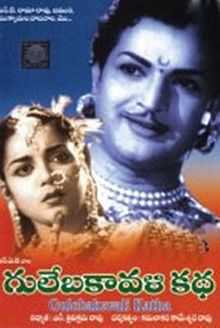Gulebakavali Katha
For information on the nocturnal flower Gul-e-Bakavali, refer Epiphyllum oxypetalum.
| Gulebakavali Katha | |
|---|---|
 | |
| Directed by | Kamalakara Kameswara Rao |
| Produced by | N. Trivikrama Rao |
| Written by |
Madhira Subbanna Deekshitulu (story) Samudrala |
| Starring |
N.T. Rama Rao Jamuna Nagaratnam Mukkamala Krishnamurthy |
| Music by | Joseph and Vijaya Krishnamurthy |
| Cinematography | Ravikant Nagaich |
| Release dates | January 5, 1962 |
| Running time | 170 minutes |
| Country | India |
| Language | Telugu |
Gulebakavali Katha (Telugu: గులేబకావళి కథ) is a 1962 Telugu fantasy film directed by Kamalakara Kameswara Rao and produced by N.Trivikrama Rao. It is based on the Kasi Majilee Kathalu written by Madhira Subbanna Deekshitulu.
The plot
King Chandrasena (Mukkamala Krishnamurthy) has two wives Gunavathi (Rushyendramani) and Rupavathi (Chayadevi). Rupavathi has three sons. Rupavathi brother Vakraketu has eye on the king’s throne. When Guanvathi gets pregnant with the blessings of the goddess Parvathi, Vakraketu along with his sister Rupavathi bribes the astrologer and tries to kill the kid, but is rescued and brought up the Shepard couple (Lanka Satyam and Hemalatha).
Once King Chandrasena goes to hunting in the forest and sees the Vijay. He lost the eyesight due to the Vakraketu poisoning the food. He blames Vijay for that. Doctors advice king to get the Gulebakavali flower which blossoms on the full moon day in the Yakshaloka.
How Vijay brings back the flower along with the two beautiful heroines and teaches the lesson to Vakraketu is the rest of the story.
Cast
- N. T. Rama Rao- Vijay
- Jamuna - Yuktimati
- Nagaratnam - Bakavali
- Mukkamala Krishnamurthy - Chandrasenudu
- Rajanala Kaleswara Rao - Vakraketu
- Chaya Devi - Rupavathi
- Rushyendramani - Gunavathi
- Chadulavada
- B. Padmanabham
- Balakrishna (Anji) - Ati Telivi
- Surabhi Balasarswathi - Adikaasa
- Peketi Sivaram
- K. V. S. Sharma
- Hemalatha
- Mikkilineni
- Boddipaati
- Nalla Ramurthy
- Lanka Satyam
- Meena Kumari
- Mahankali Venkayya
Crew
- Producer : N.Trivikrama Rao
- Direction : Kamalakara Kameshwara Rao
- Story : Samudrala Jr.
- Dialogues : Samudrala Jr.
- Music : Joseph and Vijaya Krishnamoorti (debut)
- Playback Singers : Ghantasala Venkateswara Rao, P. Susheela, Jikki Krishnaveni, Pithapuram Nageswara Rao, P. Leela, Vasantha, S. Janaki
- Lyrics : C. Narayana Reddi (debut)
- Choreography : Vempati Satyam
- Cinematography : Ravikant Nagaich
Songs
- Amba Jagadamaba Naa Aartine Alinchava (Singer: Jikki Krishnaveni)
- Anuraaga Payonidi O Janani Nee Paadame Nammiti (verse) (Singer : Ghantasala Venkateshwara Rao)
- Kaali Gajja Mee Atalinka Sagavu Maamumdu (Singer: S. Janaki)
- Kalala Alalapai Telenu Manasu Mallepoovai (Lyrics : C. Narayana Reddi; Singers: Ghantasala, S. Janaki)
- Madana Sundara Naa Doraa Naa Madini (Singer: P. Susheela)
- Matha Jaganmatha O Maata Jaganmaata (Singer: Ghantasala)
- Nannu Dhochukonduvate Vannela Dodorasaani (Lyrics : C. Narayana Reddi; Singer: Ghantasala)
- Ontarinai Poyanu Ika Intiki Emani Ponu (Singer: Ghantasala)
- Salamalekum Saahebugaaru Bhale Sokugaa Vacchaaru (Singers: Ghantasala, S. Janaki)
- Unnadi Chebuta Vintara Nenannadi Avunani Antaara (Singers: Jikki, Vasantha)
- Vinnava Tatvam Guruda Kanugunnava Satyam Narudo Naruda (Singer: Pithapuram Nageswara Rao)
- Virisindhi (Singers: Ghantasala, Jikki)
Features
- C. Narayana Reddy is debuted as Lyricist in this film. Vijaya Krishnamurthy and Joseph are also introduced as music directors in the film.
- The titles are generated by a skeleton on the screen, which was the first and only experimental feature in any folklore Telugu films.
- Heroine Nagaratnam (Bakavali Character) has only two dialogues (actually only two words) in the film. Nagaratnam (debut) is the niece of the actress Garikapati Varalaxmi. Later she acted in Mugajeevulu as heroine with her real name Prasanna Raani. She did one Tamil film Engaveettu pillai (Tamil version of Ramudu Bheemudu). Her last film is Manushullo Devudu.
- Geetanjali who earlier acted in Seetarama Kalyanam (1961) appears in a small song in the beginning with her original name Mani.
Other pictures
- Gul-e-Bakavali was the first picture with the same subject as Silent film in 1924 directed by Kanjibhai Rathod and produced by Koninoor flms. It was starring Jamna, Khalil, Fatma Begum, Noor Mohamed, Sabita Devi, Sultana, Usha Rani and Zubeida.[1] The folk-fantasy legend of the fairy Bakavali (Zubeida), her deva pushp (or divine flower) Gul known for its healing powers, and the Eastern prince Taj-ul-Mulk (Khalil), who wants the flower to cure his blind father. Taj-ul-Mulk has to face his villainous brothers who steal the flower as Bakavali is turned to stone and installed in a temple, where she undergoes her human rebirth.
- The story was made as Silent film again in 1930.
- Gul-e-Bakavali was made as Hindi films four times in 1932, 1947, 1956 and 1963.
- The story was pictured earlier in Telugu in 1938 with title Gulebakavali directed by Kallakoori Sadasivaravu and starring B. Jayamma.[2]
- The story was made as Tamil film in 1955 directed and produced by T. R. Ramanna and starring M. G. Ramachandran, T.R. Rajakumari and G. Varalakshmi
References
External links
- Gulebakavali Katha at IMDb.
- Watch the complete movie at Online Watch Movies.
- Gulebakavali Katha Movie Retrospect at Telugu Cinema.com.